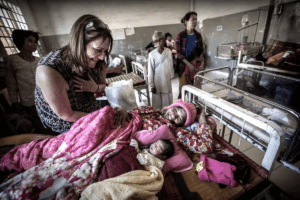Omega-3 fats are nutrients commonly found in fish and algae. Enough omega-3 in your body during pregnancy can help you have a full-term pregnancy. Babies born too soon (premature), particularly those born before 34 weeks of pregnancy, may have lengthy stays in hospital and may experience long-term health problems and delays in development.
A world-first program and partnership between SAHMRI (South Australian Health and Medical Research Institute) and SA Pathology currently enables pregnant women in South Australia to have their omega-3 levels tested and offers specific advice about supplementation to reduce their risk of early birth.
What we know about omega-3, pregnancy and preterm birth is that
* Pregnant women with low total omega-3 status early in pregnancy are at a higher risk of early preterm birth and may benefit from omega-3 supplementation.
* Conversely, women with sufficient total omega-3 status are at a lower risk, and additional omega-3 supplementation might not be helpful.
What we don’t know about omega-3,mpregnancy and preterm birth is
* The appropriate omega-3 dose for women with moderate omega-3 status.
The SAHMRI Women’s and Kids Theme are conducting a new study called the OPAL-3 Study that aims to identify the ideal dose of omega-3 for pregnant women with moderately low omega-3 status. This study is the crucial next step in an effort to further reduce preterm birth rates.
What can I do?
If you are pregnant, speak to your healthcare provider about having your omega-3 levels tested.
Your health professional can order your omega-3 screening test on the SA Maternal Serum Antenatal Screening (SAMSAS) request form. Your omega-3 level will be measured using the blood being collected for the SAMSAS program. The test is provided free to families.
Your health professional will then receive your omega-3 test results and discuss these with you at your next appointment.
Who can take part in the OPAL-3 Study?
Pregnant women who are less than 21 weeks into their pregnancy and have had their omega-3 levels tested.
What is involved?
You will be asked to complete several short questionnaires, completed online or over the phone.
You will be asked to collect 3 small blood samples from your finger, as well as a small breastmilk sample after your baby is born (optional).
Women with moderately low omega-3 levels will be provided with one of four different doses of omega-3 supplements.
This study has been approved by The Women’s and Children’s Health Network Human Research Ethics Committee #2024/HRE00064.
If you would like more information, please contact the OPAL-3 research team:
opal3@sahmri.com






